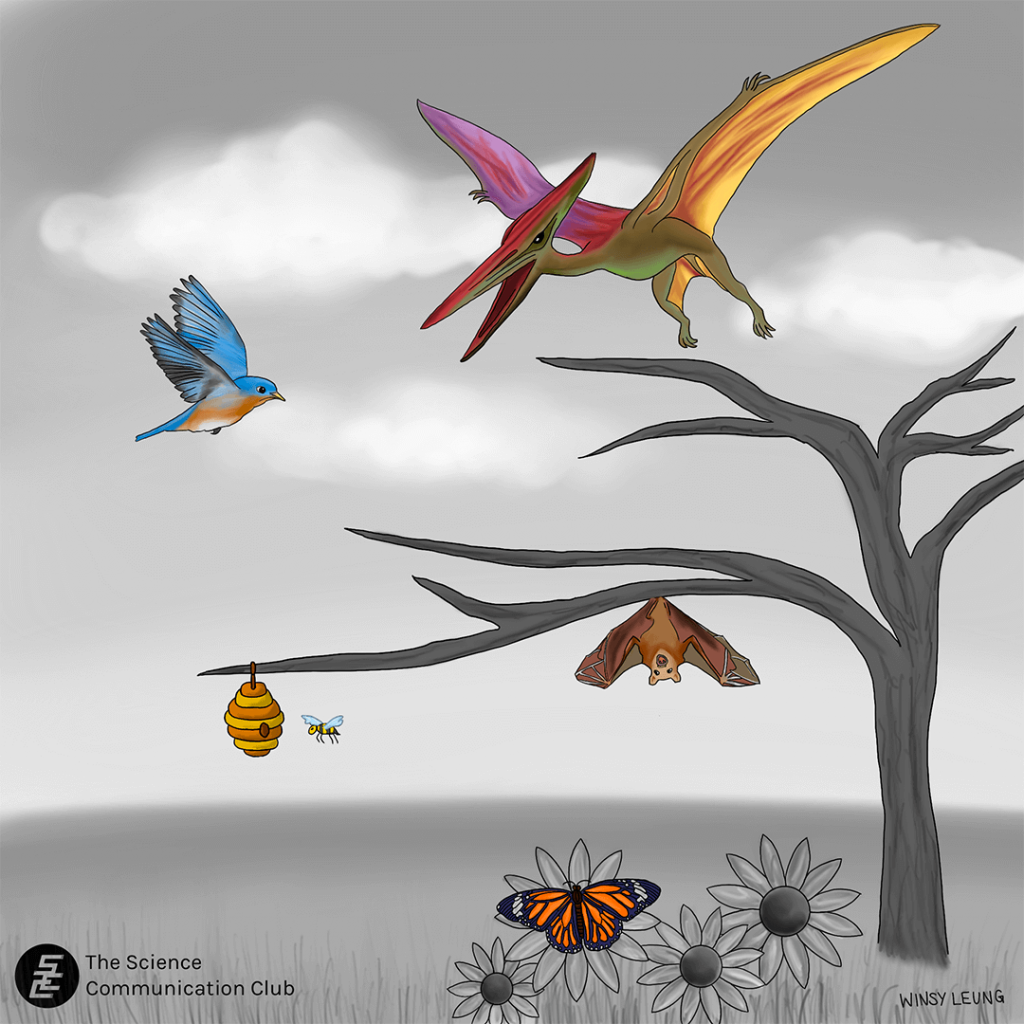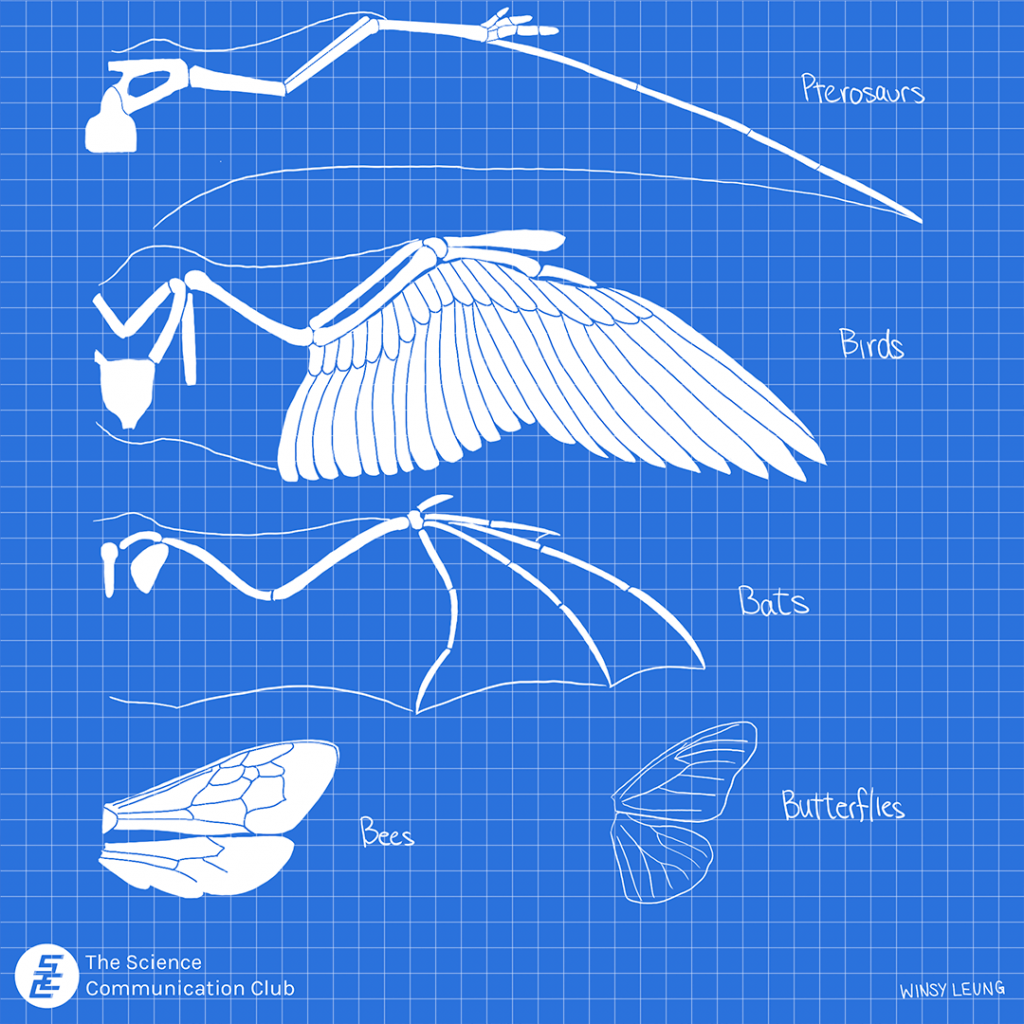
Written by Alexandra Nitoiu
Illustrated by Winsy Leung
Have you ever travelled in an airplane? Did you feel wonder at the sensation of being in the air and amazement at the view from the window? Despite having been captivated by the idea of flight since ancient times, we humans have only learned to fly after the Wright brothers’ inaugural flight in 1903. The animal kingdom, on the other hand, has been doing it for far longer! Pterosaurs, birds, bats, and insects were the first to evolve the ability to fly, and in modern times, insects, birds, and bats are capable of true flight. So how exactly did this nearly 400 million year old process first start?
The Evolution of Flight
Insects were the first to gain the ability to fly during the early Devonian period around 406 million years ago, after complex terrestrial ecosystems developed and insects diversified!1 But they weren’t the only ones to do so: flight evolved independently four times in insects, pterosaurs, birds, and bats through convergent evolution.2 This means that they didn’t share a common ancestor; instead, similar demands in their respective environments prompted them to develop the ability separately. There has actually been a debate since the 1880s about how flight developed, and there are two main competing theories. The ground-up theory suggests that flight evolved in ground-dwelling ancestors, and the trees-down theory suggests that flight evolved in ancestors that leapt and glided between trees.3 While it’s pretty hard to test these two theories, understanding why flight evolved is more straightforward. Gaining the ability to maneuver in the air helps animals escape from predators, catch prey, move from one place to another, and find new food sources and places to live.3 And although they all evolved the ability to fly, insects, pterosaurs, birds, and bats all do so in different ways.
Types of Flight
At this point, we should define true flight. You see, many animals can travel in the air, but not all of them technically fly. For example, some animals parachute, meaning that they fall while slowing their descent through the air.4 Spiders can do this by spinning a little triangular parachute out of silk, and soaring along with the breeze in a behaviour known as ballooning. Other animals like flying squirrels, ray-finned fish, and flying frogs can glide, which is similar to parachuting except they have adaptations that allow them to travel further horizontally by slowing their fall even more.4
Unlike gliders and parachuters who passively descend through the air, true fliers flap their wings to achieve true powered flight and have more control over their movements, being able to move horizontally and ascend.4 However, some true fliers soar, which looks similar to gliding but involves specific adaptations. To soar, an animal coasts on warm rising air to stay at a constant altitude. Soaring animals don’t need to flap their wings to take off, land, or adjust their flight. Only a few animals such as large birds and pterosaurs have been able to soar over the course of evolutionary history.4
Invertebrate Flight
Even among true fliers, there are differences between invertebrate and vertebrate flight. When it comes to invertebrates, most flying adult insects have developed two pairs of wings.5 Unlike vertebrate wings, insect wings evolved from horizontal extensions of their chest instead of structures that used to be limbs. The wings are made up of two layers of sclerotin, a flexible but strong substance that also covers the insect’s body. Insect wings can beat up and down as well as twist at the base, letting the insect fly in many different directions. Two types of chest muscles control the wings depending on the insect species: direct or indirect flight muscles. Insects like bees, moths, and flies control their flight well using indirect flight muscles, which are attached to the chest but not the wings directly, but evolutionarily older insects like dragonflies and grasshoppers use direct flight muscles which attach right to the wings. While many insects like dragonflies can use their front and back wings independently to maneuver and turn, other insects such as bumblebees have small hooks along their front wings that latch onto their back wings to move them together. Unlike vertebrate fliers, insects don’t fly in a straight line, but some of them can still be fast, with dragonflies reaching almost 60 kilometres per hour over short distances!5

Vertebrate Flight
The first vertebrates to evolve true flight were the pterosaurs—ancient flying reptiles.6 Initially thought to be only gliders, it’s now known that they were proficient fliers.6 They evolved around 225 million years ago, and the fossil record tell us that in their case, the ground-up evolutionary theory is most likely.6 The largest pterosaurs, such as Pteranodon and Quetzalcoatlus, were so large that they could only soar; they were the largest known fliers on Earth, standing at 3.6 metres tall with a 12-metre wingspan!7
The next group of fliers to evolve were the birds, who shared a common ancestor with dinosaurs during the late Jurassic period, around 150 million years ago.8 Birds and pterosaurs have similar flight adaptations including hollow but strong bones, bones modified to allow for the attachment of flight muscles, and feathers (or wing fibers for pterosaurs).8 The shapes of bird wings are good at catching the air, their lungs are efficient at getting oxygen so they can fly very far without getting tired, and they eat lots of high-energy food.9 Birds are diverse both in species and in their flight adaptations. Diving birds such as penguins have adapted their wings to fly through water instead of air.8 Even among the birds that fly in the air, there’s a lot of variety in their body types and flying techniques; smaller birds like swallows and hummingbirds move quite differently from larger birds like falcons and soaring albatrosses.
On one hand, we have hummingbirds, which can beat their wings up to 200 times per second! While most birds beat their wings up and down, hummingbirds move their wings forward and backward, rotating their wings up to 180 degrees at the shoulder. As a result, their wingtips make a horizontal figure eight in the air with each wing beat, generating enough lift to let the birds hover.10 On the other hand, we have peregrine falcons, which are large predatory birds and the fastest members of the animal kingdom. By folding their wings in to minimize drag, peregrine falcons can dive through the air at incredibly high speeds. Their fastest recorded speed was 389 kilometres per hour!11
Bats evolved last, around 60 million years ago, and are the only mammals to evolve true powered flight.12 The current leading hypothesis is that they probably evolved from a gliding ancestor that lived in trees, supporting the trees-down theory. Unlike bird wings, bat wings are made of a membrane supported by the arm and the elongated fingers of the hand. Bats have also developed other flight adaptations such as echolocation, clawed fingers, a high metabolic rate, and a membrane stretched between their hindlimbs to stabilize their flight and catch prey.12
After reading about all these high-achieving animals, you might no longer be as impressed with human airplanes. As usual, mother nature’s inventiveness gives us a run for our money, but in the end, aren’t all of our achievements ultimately hers as well? Birds and bats have long inspired those who worked towards inventing human flight, and we’ve still got a lot left to learn about how flight works and how it evolved. Who knows, we might soon be using albatross soaring aerodynamics to improve gliders!
Sources:
- Misof B, Liu S, Meusemann K, Peters RS, Donath A, Mayer C, Frandsen PB, Ware J, Flouri T, Beutel RG, et al. Phylogenomics resolves the timing and pattern of insect evolution. Science. 2014;346(6210):763–767. https://www.science.org/doi/abs/10.1126/science.1257570. doi:10.1126/SCIENCE.1257570/SUPPL_FILE/1257570S9.XLS
- The Evolution of Flight. Science World. 2016 Dec 21. https://www.scienceworld.ca/stories/evolution-flight/
- Hutchinson JR. The Origins of Flight. University of California Museum of Paleontology. 1996 Jan 11. https://ucmp.berkeley.edu/vertebrates/flight/origins.html
- Hutchinson JR. Vertebrate Flight: Introduction. University of California Museum of Paleontology. 1996 Jan 11. https://ucmp.berkeley.edu/vertebrates/flight/flightintro.html
- How Do Insects Fly? North American Nature. https://northamericannature.com/how-do-insects-fly/
- Hutchinson JR. Pterosaurian Flight. University of California Museum of Paleontology. 1996 Jan 11. https://ucmp.berkeley.edu/vertebrates/flight/pter.html
- Fuge L. How did the world’s largest pterosaur fly? Cosmos. 2021 Dec 8. https://cosmosmagazine.com/history/palaeontology/how-did-the-worlds-largest-pterosaur-fly/
- Hutchinson JR. Avian Flight. University of California Museum of Paleontology. 1996 Jan 11. https://ucmp.berkeley.edu/vertebrates/flight/aves.html
- Bostwick K. How do birds fly? The Cornell Lab of Ornithology. https://celebrateurbanbirds.org/faq/how-do-birds-fly/
- Mayntz M. Guide to Hummingbird Flight. The Spruce. 2021 Mar 13. https://www.thespruce.com/how-hummingbirds-fly-386446
- Wasser J. Terminal Velocity. National Geographic Society. 2012 Jan 27. https://www.nationalgeographic.org/media/terminal-velocity-wbt/